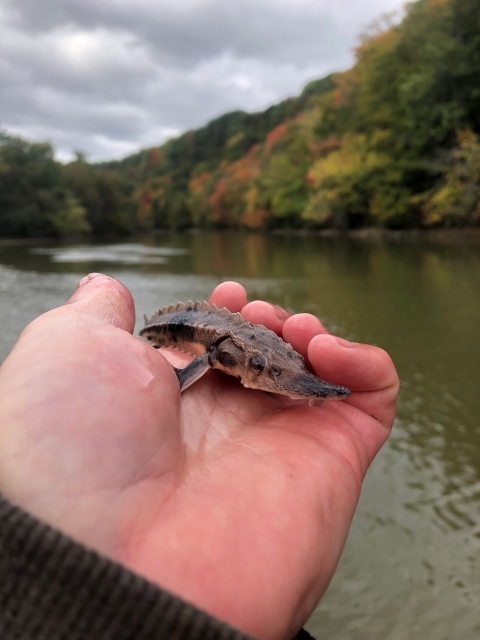Sea lampreys are voracious, invasive predators that threaten the health of the Great Lakes fish community. To keep sea lamprey populations in check, lampricides are applied to streams
throughout the Great Lakes. From August 16-25, 2022, the U.S. Fish and Wildlife Service Sea Lamprey Control Program (SLCP) and Department of Fisheries and Oceans Canada orchestrated a lampricide treatment on the Muskegon River in Fremont, Michigan.
To conduct a successful treatment, the SLCP must coordinate with other state, federal, and tribal partners to work toward conservation goals that may sometimes overlap. The lake sturgeon is a species of concern as juveniles can be sensitive to lampricides in highly alkaline streams, such as the Muskegon River. Since sturgeon are slow to mature and population growth takes time, young-of-year sturgeon are removed from the river prior to the treatment in a collaborative effort known as the “sturgeon round-up.” This effort was led by the Little River Band of Ottawa Indians with support from the SLCP Risk Management Team, the Green Bay Fish and Wildlife Conservation Office, and Michigan Department of Natural Resources.
Around 8 p.m. each night, the crews launched their boats from pre-determined locations to ensure there was adequate river coverage. As darkness enveloped the crews, juvenile sturgeon were identified with spotlights and netted from the boats. As sturgeon are typically found in shallower areas with gravel-sand substrate, the boats moved slowly upstream through shallow waters. Throughout the night, teams methodically scanned the appropriate habitat with the hope of spotting the twinkle reflection of sturgeon eyes. The team excitement (and adrenaline!) that was generated during a successful capture carried our tired bodies and eyes through the late hours. Though there were challenges – motor malfunctions, dense vegetation, unfamiliar river channels, and shallow water – the teams successfully collected a total of 46 sturgeon: 45 YOY and a sturgeon estimated to be one year old. A single location provided a surprise collection of 11 sturgeon. No matter whether you were a seasoned night sturgeon netter or new to the collection efforts, the air was buzzing with excitement!
The Little River Band of Ottawa Indians housed the collected sturgeon at the Ed H. Henning County Park in Newaygo, Michigan during the lampricide treatment. After the lampricide cleared the river, all sturgeon were tagged and released into their respective river sections, making the effort a success.
For some of us, this was our first experience with sturgeon – both in spotlighting at night and meeting these incredible creatures in-person! This coordinated effort was an important reminder that partnerships and collaborations are central to the mission of the USFWS and are key to protecting the Great Lakes fish community.




